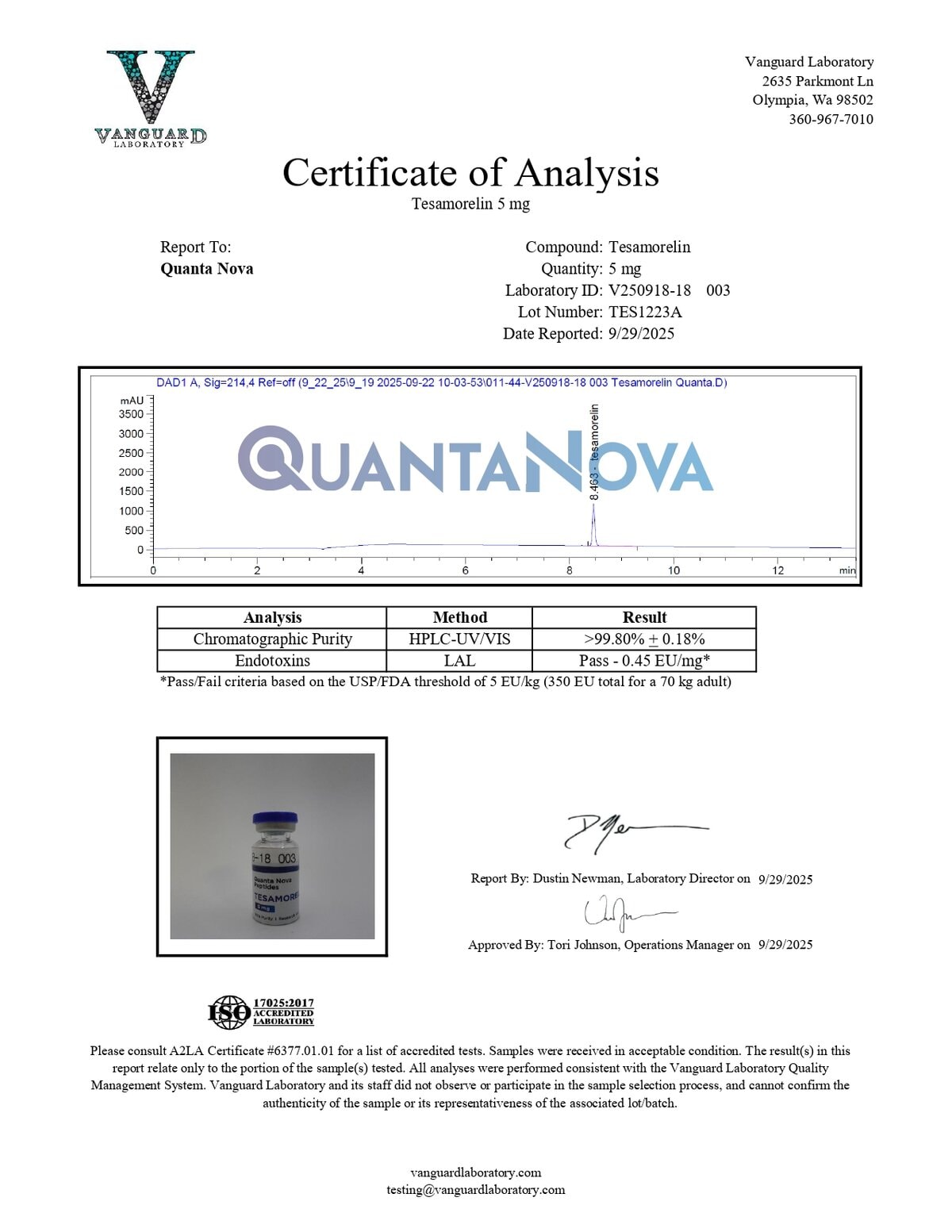Description
Product Overview
QuantaNova’s Tesamorelin 5mg is offered in a 4-vial bundle of lyophilized powder, formulated for research applications. Each vial is produced with in-house lyophilization, using a proprietary stabilization process to preserve integrity during temperature fluctuations. This includes protection against heat and cold throughout the shipping process for up to 30 days before refrigeration becomes necessary..
We implement strict quality control standards across every peptide batch and utilize PES micron filtration to eliminate potential contaminants. Third-party verification is conducted by Vanguard Laboratory—an ISO-certified facility—to ensure identity, purity, quantity, and endotoxin levels meet rigorous benchmarks. QuantaNova is trusted by researchers for transparency and consistency.
Tesamorelin Peptide Structure
- Amino Acid Sequence: Tyr–Gly–Asp–Ala–Ile–Phe–Thr–Asn–Ser–Tyr–Arg–Lys–Val–Leu–Gly–Gln–Leu–Ser–Ala–Arg–Lys–Leu–Leu–Gln–Asp–Ile–Met–Ser–Arg–Gly–Ile–Arg–Gln–Gln–Gly–Glu–Ser–Asn–Gly–Ala–Pro–Leu–Gly–Ser–Pro–Arg–Ala–Arg–Leu–NH₂
- Molecular Formula: C221H366N72O67S
- Molecular Weight: 5135.78 g/mol
- CAS Number: 218949-48-5
Key Findings of Tesamorelin
- Studied for its ability to stimulate growth hormone (GH) release in clinical and animal models
- Explored in relation to reducing visceral fat accumulation
- Examined for its effect on IGF-1 levels and downstream anabolic signaling pathways
- Investigated for potential applications in metabolic regulation and lipid processing
In-Depth Research Applications of Tesamorelin
Growth Hormone Secretion and IGF-1 Modulation
Tesamorelin is a synthetic peptide analog of growth hormone-releasing hormone (GHRH) that has demonstrated a high affinity for GHRH receptors. In laboratory models, it has been shown to stimulate endogenous GH production, which in turn can elevate insulin-like growth factor 1 (IGF-1). This signaling cascade has been widely studied for its potential effects on growth, recovery, and cellular metabolism.
Fat Metabolism and Visceral Adipose Research
One of the most prominent applications of Tesamorelin is in studies of fat distribution, particularly in the context of visceral adipose tissue (VAT). Research shows Tesamorelin may help modulate lipid metabolism pathways, which could impact how fat is stored and broken down in central body regions. These studies are especially relevant in models simulating metabolic syndrome, lipodystrophy, or insulin resistance.
Anabolic and Muscle-Preserving Effects
In animal models, Tesamorelin has also been evaluated for its role in lean muscle preservation and protein synthesis through IGF-1 stimulation. By supporting these pathways, Tesamorelin may offer a protective mechanism against muscle degradation in catabolic states, making it a candidate for research on sarcopenia and age-related muscle decline.
Neurological and Cognitive Interest
Emerging research has begun to explore Tesamorelin’s indirect influence on cognitive function. Some findings suggest the peptide’s impact on GH/IGF-1 pathways could be relevant in neuroprotective and brain health models. While data is still in early stages, this is a growing area of interest in laboratory investigations.
References
-
Growth Hormone Secretion and IGF-1 Modulation
-
Fat Metabolism and Visceral Adipose Research
-
Anabolic and Muscle-Preserving Effects
-
Neurological and Cognitive Interest
Usage & Storage Guidelines of Tesamorelin
- Handle using appropriate laboratory safety procedures.
- Storage (Lyophilized): Store at -20°C.
- After Reconstitution: Store between 2–8°C and use within 14–30 days.
- Diluent Recommendation: Reconstitute with bacteriostatic water or a suitable research-grade diluent.
Legal Disclaimer
This product is intended strictly for laboratory research purposes only. It is not a drug, food additive, cosmetic, or therapeutic substance, and must not be used in humans or animals. It is the buyer’s responsibility to handle the product safely and in accordance with applicable laws and regulations.











Reviews
There are no reviews yet